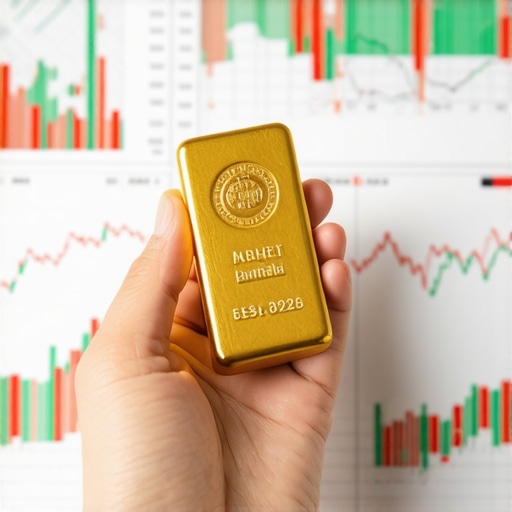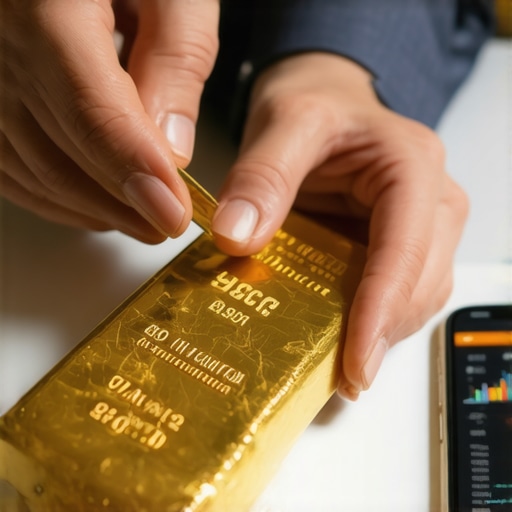Unlocking the Golden Gateway: Why a Gold IRA Could Be Your Retirement Game-Changer
In an era of financial uncertainty and fluctuating markets, diversifying your retirement portfolio with a Gold IRA emerges as a compelling strategy for safeguarding wealth. Unlike traditional IRAs, a Gold IRA allows you to hold physical gold or other precious metals as a tax-advantaged investment, providing a hedge against inflation and currency devaluation. This comprehensive guide is designed to demystify the process of starting a Gold IRA, empowering beginners to make informed decisions backed by expert insights.
Decoding the Gold IRA: Beyond the Basics of Precious Metal Retirement Accounts
At its core, a Gold IRA is a self-directed Individual Retirement Account that permits investment in physical gold, silver, platinum, and palladium, diverging from typical stock or bond holdings. This flexibility requires understanding IRS regulations, including the types of approved precious metals and storage requirements. Establishing a Gold IRA involves selecting a reputable custodian to manage the account and a trusted dealer for purchasing the precious metals, ensuring compliance with IRS standards and safeguarding your investment.
What Are the Key Steps to Successfully Starting a Gold IRA?
Starting a Gold IRA entails a methodical approach:
- Choose a Self-Directed IRA Custodian: Seek firms specializing in precious metals IRAs with transparent fee structures and strong customer support.
- Open and Fund Your Account: You can roll over funds from an existing IRA or 401(k) without tax penalties, or make a new contribution within IRS limits.
- Select Your Precious Metals: Opt for IRS-approved coins or bars, known for purity and authenticity, such as American Gold Eagles or Canadian Maple Leafs.
- Purchase and Secure Storage: Buy through your custodian’s recommended dealers and store your metals in an IRS-approved depository to meet regulatory requirements.
Each step demands careful attention to detail to optimize tax benefits and investment security.
Expert Tips to Navigate the Gold IRA Landscape Wisely
Investing in a Gold IRA is not a mere transactional process; it requires strategic planning. For instance, balancing your portfolio with other assets can mitigate volatility. Understanding market trends—like the current global gold demand influenced by central bank purchases—can enhance timing decisions. Additionally, be vigilant about fees, including setup, storage, and transaction costs, which can erode returns over time. Engaging with industry experts or accessing authoritative resources such as the IRS guidelines on precious metals IRAs can provide critical compliance clarity.
Integrating Your Gold IRA into a Diversified Retirement Strategy
Gold IRAs are most effective when integrated thoughtfully into a broader retirement plan. Combining physical gold with gold ETFs or mutual funds can offer liquidity and growth potential, tailoring risk levels to your comfort zone. For beginners interested in ETFs, our Ultimate Guide to Choosing Gold ETFs for Smart Investing offers valuable insights on balancing physical and paper gold investments.
Curious about the Risks and Rewards? Understanding Gold IRA Volatility and Long-Term Benefits
While gold is traditionally a stable store of value, it is not immune to market fluctuations or geopolitical influences. It’s essential to recognize that Gold IRAs are best viewed as long-term insurance against economic downturns rather than vehicles for rapid gains. Historical data shows gold’s resilience during inflationary periods and currency crises, but timing and market conditions can impact short-term performance. Thorough research and consultation with financial advisors can help align your Gold IRA with your retirement goals and risk tolerance.
Ready to embark on your Gold IRA journey? Share your thoughts or questions below to join a community committed to secure retirement investing and explore further resources tailored for beginners.
Reflecting on the Emotional Side of Investing in a Gold IRA
When I first decided to diversify my retirement portfolio with a Gold IRA, it was more than a financial decision—it was a journey into understanding my own comfort with risk and security. I remember feeling a mix of excitement and apprehension, wondering if holding physical gold would truly provide the peace of mind I sought. Over time, I’ve come to appreciate that investing in gold isn’t just about numbers; it’s about building a tangible sense of control in uncertain times.
What Should You Watch Out For When Choosing Your Gold IRA Custodian and Dealer?
One of the trickiest parts of setting up a Gold IRA is selecting the right custodian and dealer. I learned this firsthand after encountering a few options that sounded promising but had hidden fees or less-than-transparent policies. A trusted custodian should be clear about all associated costs and provide strong support, while your dealer must offer authentic, IRS-approved metals. It’s worth spending time reading reviews and even reaching out to other investors. For example, the IRS recommends certain standards for precious metals IRAs, which I found very helpful when researching trusted providers (IRS guidelines on precious metals IRAs).
How Do You Balance Physical Gold with Other Gold Investment Options?
In my experience, relying solely on physical gold can feel limiting, especially when you want liquidity or growth potential. That’s why I mixed my Gold IRA holdings with gold ETFs and mutual funds. This balanced approach allowed me to enjoy the safety of physical bars and coins while capitalizing on market opportunities through paper gold. If you’re new to this, our Ultimate Guide to Choosing Gold ETFs for Smart Investing breaks down how to blend these assets effectively, making it easier to tailor your portfolio to your risk tolerance.
Have You Considered How Global Gold Demand Trends Might Affect Your Gold IRA?
One question that intrigued me early on was how global demand impacts gold prices—and by extension, my Gold IRA’s value. Reading up on market dynamics revealed fascinating insights, such as how central bank purchases and industrial demand can shift prices unexpectedly. In fact, according to recent analysis from market experts, the interplay between supply constraints and rising demand in emerging economies is a critical driver behind gold’s price fluctuations (Understanding Global Gold Demand Trends Impacting Prices).
Keeping an eye on these trends helped me time some purchases and sales more effectively, though I always reminded myself that gold investing is a marathon, not a sprint.
Practical Tips to Safeguard Your Physical Gold Investment
Securing physical gold is another layer of responsibility. Initially, I stored my bars at home, but I quickly realized the risks involved. Transitioning to an IRS-approved depository, recommended by my custodian, offered peace of mind and compliance with regulations. For those exploring this route, detailed advice is available in resources like Physical Gold Investment Tips: How to Buy Bars Securely, which guided me through choosing reputable storage and handling logistics safely.
Investing in a Gold IRA is as much about managing trust and responsibility as it is about the financials.
Sharing and Learning Together: Your Gold IRA Experiences Matter
Have you started or considered starting a Gold IRA? What challenges or surprises have you encountered along the way? Sharing experiences can empower all of us to make smarter, more confident investment decisions. Feel free to comment below with your stories or questions. And if you found these insights helpful, don’t hesitate to explore more in-depth guides we offer on related topics like using physical gold bars as a hedge against inflation or comparing gold ETFs and mutual funds for portfolio diversification.
Dissecting the Complex Fee Structures of Gold IRAs: How to Avoid Hidden Costs and Optimize Returns
While the allure of a Gold IRA lies in its ability to safeguard wealth through physical assets, many investors overlook the intricate fee structures that can silently erode their returns. Custodial fees, storage charges, transaction costs, and setup expenses cumulatively impact your net gains over time. A sophisticated investor must scrutinize the fee schedule beyond surface-level disclosures. For instance, some custodians charge annual fees upwards of $300, while others offer tiered pricing based on account size. Storage fees for IRS-approved depositories vary by location and metal weight, with additional surcharges for insurance and secure transportation.
Understanding the interplay of these fees enables you to negotiate better terms or select custodians with transparent, competitive pricing. Engaging in a thorough cost-benefit analysis comparing custodians and storage providers can significantly enhance your Gold IRA’s profitability over the long term.
Advanced Tax Implications and Compliance Strategies for Gold IRA Investors
Gold IRAs benefit from tax advantages inherent in traditional and Roth IRAs, yet the unique characteristics of physical precious metals introduce additional tax considerations. For example, distributions from a traditional Gold IRA are taxed as ordinary income upon withdrawal, but the IRS requires that the physical metals remain in IRS-approved depositories, restricting direct possession until retirement.
Moreover, investors must navigate the collectibles tax rules which impose a higher capital gains tax rate if precious metals are held outside an IRA or after distribution. Strategic rollovers can defer taxation, but improper handling can trigger penalties.
Consulting with tax professionals who specialize in precious metals IRAs is invaluable for tailoring strategies that align with your retirement timeline and minimize tax liabilities. The IRS Retirement Plans FAQs on IRAs and Other Retirement Plans provide authoritative guidelines to ensure compliance and optimize tax outcomes.
How Can Investors Strategically Manage Required Minimum Distributions (RMDs) from Gold IRAs?
Required Minimum Distributions (RMDs) pose a unique challenge for Gold IRA holders due to the illiquid nature of physical metals. Unlike traditional IRAs, where distributions can be made in cash or securities, Gold IRA owners must liquidate a portion of their holdings to meet RMD obligations, potentially incurring unfavorable market timing risks and additional transaction fees.
Advanced strategies include pre-planning partial liquidations during favorable market conditions or maintaining a hybrid portfolio combining physical metals with liquid gold ETFs to ease RMD compliance. Some investors also consider Roth conversions to mitigate RMD requirements altogether. These nuanced approaches necessitate close collaboration with financial advisors versed in precious metals and tax law.
Leveraging Market Analytics and Predictive Models to Time Gold IRA Purchases
Beyond traditional buy-and-hold tactics, expert investors incorporate sophisticated market analytics and predictive modeling to optimize entry and exit points for Gold IRA investments. Utilizing data on geopolitical risk indices, inflation expectations, central bank policies, and currency fluctuations enables more informed timing decisions.
For instance, econometric models that correlate gold prices with real interest rates and emerging market demand can forecast potential price inflection points. Although no model can guarantee precision, integrating these insights with qualitative geopolitical assessments enhances portfolio resilience and growth potential.
For those interested in deepening their understanding, the World Gold Council’s comprehensive research on gold price drivers offers expert-level analysis and empirical data essential for strategic decision-making.
Ready to elevate your Gold IRA strategy with advanced insights and personalized guidance? Explore our expert consultation services designed to tailor your precious metals portfolio to your unique financial goals.
Decoding Hidden Costs: A Deep Dive into Gold IRA Fee Structures
While the allure of a Gold IRA lies in its capacity to provide tangible asset security, many sophisticated investors overlook how layered fees can silently erode long-term gains. Custodial fees often vary widely, with some providers charging steep annual rates that disproportionately impact smaller accounts. Storage fees, charged by IRS-approved depositories, can fluctuate based on location, security level, and metal volume, while transaction costs—often overlooked—may accumulate with frequent trades. An expert approach involves meticulously dissecting fee schedules, negotiating terms where possible, and selecting custodians offering transparent, scalable pricing models tailored to your portfolio size.
Unraveling Tax Complexities: Strategic Compliance and Optimization for Gold IRA Investors
Gold IRAs, while offering compelling tax deferral benefits, introduce nuanced challenges distinct from traditional retirement accounts. The IRS mandates that physical precious metals remain in approved depositories until distribution, complicating direct possession strategies. Furthermore, understanding the intersection of IRA distributions and collectibles tax rules is critical; improper handling can trigger higher capital gains tax rates and penalties. Advanced investors benefit from engaging tax professionals specializing in precious metals to architect rollover strategies and distribution plans that minimize tax liabilities while adhering to regulatory frameworks.
How Can Investors Strategically Manage Required Minimum Distributions (RMDs) from Gold IRAs Without Compromising Portfolio Integrity?
Required Minimum Distributions present a multifaceted challenge for Gold IRA holders due to the illiquidity of physical metals. Liquidating assets to satisfy RMDs risks unfavorable market timing and additional transaction fees. Sophisticated strategies include preemptive partial liquidations during optimal market windows, maintaining a hybrid portfolio combining physical metals with liquid gold ETFs, or executing Roth conversions to circumvent RMD obligations. These approaches necessitate proactive planning and collaboration with advisors versed in both precious metals and retirement tax law to align distributions with personal financial goals.
Harnessing Market Analytics and Predictive Modelling for Optimal Gold IRA Timing
Beyond traditional buy-and-hold paradigms, leveraging advanced econometric models and geopolitical risk analytics can significantly enhance Gold IRA investment outcomes. Integrating variables such as real interest rates, inflation expectations, currency fluctuations, and emerging market demand helps forecast price inflection points. While no model guarantees exact timing, coupling quantitative data with qualitative geopolitical assessments improves decision-making resilience. The World Gold Council’s comprehensive research on gold price drivers is an indispensable resource for investors seeking empirical insights and expert analysis to refine timing strategies.
Ready to elevate your Gold IRA strategy with these advanced insights? Connect with our expert advisors for personalized portfolio optimization tailored to your unique financial objectives.
Frequently Asked Questions (FAQ)
What exactly is a Gold IRA and how does it differ from a traditional IRA?
A Gold IRA is a self-directed Individual Retirement Account that allows you to invest in physical precious metals such as gold, silver, platinum, and palladium, instead of traditional assets like stocks or bonds. Unlike traditional IRAs, it requires compliance with IRS rules regarding approved metals and storage in IRS-approved depositories, offering a tangible hedge against inflation and currency risk.
How do I choose the right custodian and dealer for my Gold IRA?
Choosing a custodian and dealer involves evaluating transparency in fees, reputation, IRS compliance, and customer service quality. The custodian manages the IRA account and ensures regulatory adherence, while the dealer supplies IRS-approved metals. Researching reviews, verifying credentials, and consulting IRS guidelines help mitigate risks associated with hidden fees or illegitimate metals.
Can I include both physical gold and gold ETFs in my retirement portfolio?
Yes, many investors combine physical gold held in a Gold IRA with gold ETFs or mutual funds to balance liquidity and growth potential. This hybrid approach allows you to benefit from the stability of physical assets and the flexibility of market-traded securities, tailoring risk to your investment goals.
What are the key fees associated with Gold IRAs and how can they affect my returns?
Common fees include setup charges, annual custodial fees, storage costs at approved depositories, and transaction fees when buying or selling metals. These fees can accumulate and reduce net returns if not carefully managed. Comparing fee structures and negotiating terms where possible are essential to optimizing your investment performance.
How do Required Minimum Distributions (RMDs) work for Gold IRAs?
RMDs require retirees to withdraw a minimum amount annually starting at age 73. For Gold IRAs, because holding physical metals is illiquid, you typically need to liquidate part of your holdings to meet RMDs, which can incur transaction fees and timing risks. Strategies to manage RMDs include partial liquidations during favorable market conditions or maintaining a mixed portfolio with liquid assets.
Are there specific tax implications unique to Gold IRAs?
Yes, distributions from Gold IRAs are taxed as ordinary income upon withdrawal, similar to traditional IRAs. However, because the metals are physical collectibles, there are additional IRS rules restricting possession and imposing higher tax rates if metals are withdrawn improperly. Consulting with tax professionals specialized in precious metals IRAs is crucial for compliance and tax efficiency.
How can market analytics improve my Gold IRA investment timing?
Utilizing advanced models that analyze geopolitical risks, inflation trends, real interest rates, and global demand can help forecast gold price movements. While timing the market perfectly is impossible, informed decisions based on data and expert research, such as reports from the World Gold Council, enhance portfolio resilience and potential returns.
What storage options are available for physical gold in a Gold IRA?
IRS rules mandate that physical metals in a Gold IRA be stored in approved, secure depositories. Options include third-party vaults with robust security and insurance. Storing metals at home or non-approved locations violates IRS regulations and risks penalties. Choosing reputable depositories recommended by your custodian ensures compliance and asset safety.
Can I roll over my existing 401(k) or IRA into a Gold IRA?
Yes, you can roll over funds from eligible retirement accounts like 401(k)s or traditional IRAs into a Gold IRA without incurring immediate tax penalties if done properly. This rollover must be executed through a qualified custodian to maintain tax-advantaged status.
What risks should I consider before investing in a Gold IRA?
Risks include market volatility, illiquidity of physical metals, custodial and storage fees, and regulatory compliance complexities. Gold IRAs are best suited as long-term hedges rather than short-term speculative tools. Diversifying your retirement portfolio and consulting financial advisors can mitigate these risks.
Trusted External Sources
- IRS Official Website – Retirement Plans FAQs on IRAs and Precious Metals: Provides authoritative guidance on tax regulations, IRS-approved metals, and compliance requirements critical for Gold IRA investors.
- World Gold Council – Research and Gold Price Drivers: Offers in-depth empirical data and expert analyses on factors influencing gold prices, essential for strategic timing and market understanding.
- U.S. Securities and Exchange Commission (SEC) – Guide on Self-Directed IRAs: Details regulatory considerations and investor protections relevant to managing Gold IRAs and selecting custodians.
- Financial Industry Regulatory Authority (FINRA) – Investor Alerts on Precious Metals: Educates investors about risks, fraud prevention, and due diligence in precious metals investments.
- National Association of Unclaimed Property Administrators (NAUPA) – Custodian and Dealer Verification Resources: Helps verify legitimacy and reputation of custodians and dealers to avoid scams.
Conclusion
Investing in a Gold IRA presents a sophisticated avenue to secure retirement wealth through tangible assets that historically withstand economic uncertainty. This strategy requires a nuanced understanding of IRS regulations, fee structures, tax implications, and market dynamics. By carefully selecting reputable custodians and dealers, balancing physical and liquid gold investments, and employing advanced analytical tools, investors can optimize their Gold IRA’s performance and compliance. Remember, success in Gold IRA investing hinges not only on the assets themselves but on informed planning, strategic timing, and ongoing expert consultation. Engage with this knowledge actively—share your experiences, seek tailored advice, and explore related resources to fortify your financial future with confidence and clarity.










